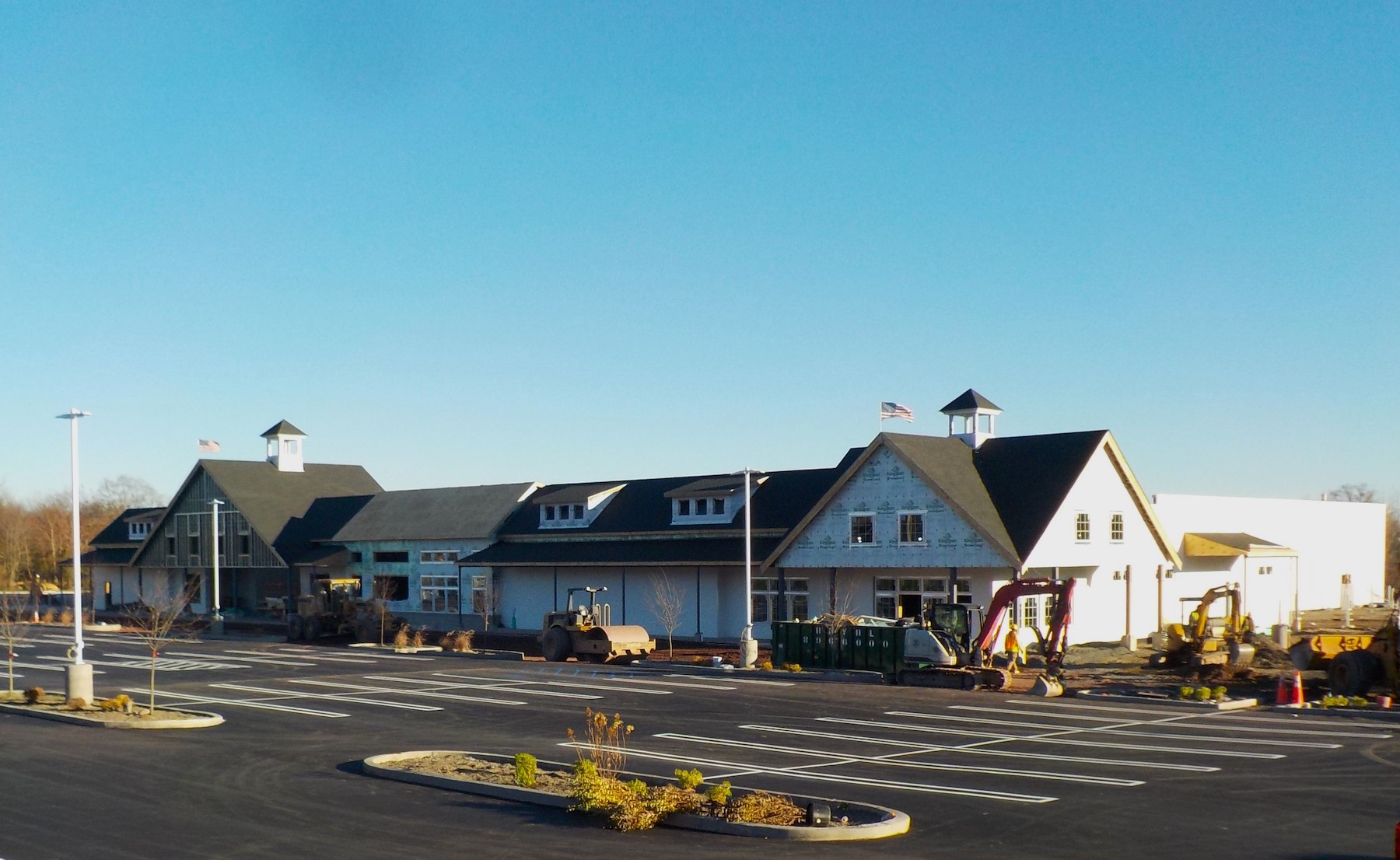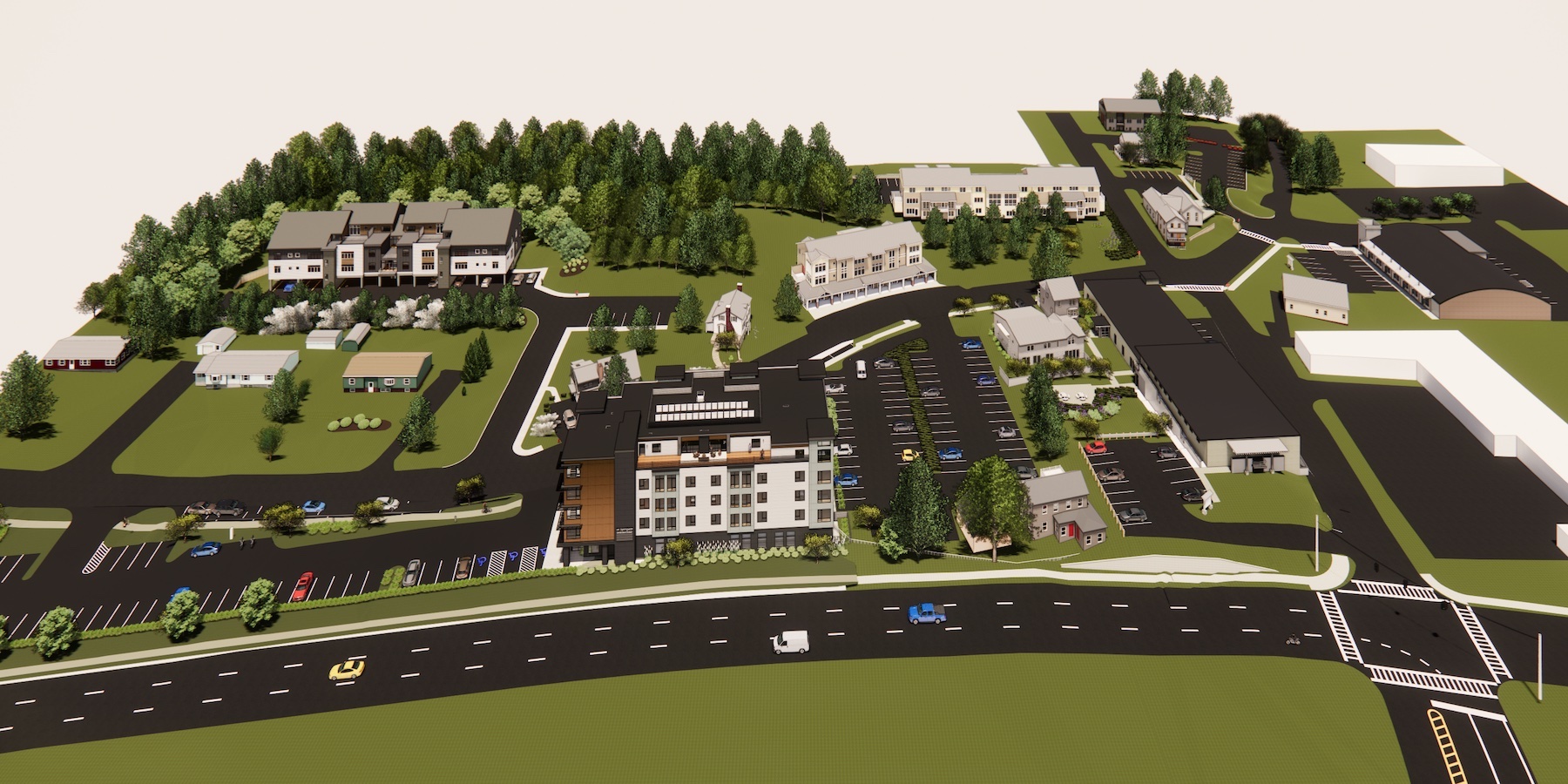Tinkelman Architecture is preparing to break ground on a five-story building, located at the Van Wagner Place mixed-use campus in Poughkeepsie, N.Y., that will have 28 luxury apartments, commercial space on the first floor with an indoor pool that will be used by the British Swim School franchise, and a top-floor community space that opens onto a roof deck.
Tinkelman Companies, the firm’s development and property management arm, has been involved with Van Wagner Place for a decade, starting with the renovation and repurposing of four derelict buildings. The campus is now home to offices, shops, and other businesses, as well as the firm’s headquarters inside a former warehouse in Poughkeepsie’s Arlington business district.
In fact, over the 30 years it has been serving New York’s Hudson Valley, Tinkelman Architecture has been the designer on more than 100 projects within that market. Its fingerprints can be found on local banks, wineries, restaurants, retail stores, historic structures and parks, to say nothing of the numerous residential projects it has engaged.
“We like doing a lot of housing,” says Steven Tinkelman, a Poughkeepsie native and life-long Hudson Valley resident, who founded Tinkelman Architecture in 1993. Over the years, his work has contributed to this market becoming, in his words, “more sophisticated, regional, cosmopolitan.”
Tinkelman Architecture generates between $1 million and $2 million per year in revenue from its design work, and double that when development and property management are included.
Wide-ranging projects
A graduate of Cooper Union and a modernist by training, Tinkelman also acknowledges the aesthetic influence of rustic summer camping as a child. “So there’s a blending of modern tradition with sticks and twigs,” he quips.
His 14-person firm has no signature architectural style, and he is fine with that agnostic approach because he believes it opens portals to pursue a diversity of projects in a market where, he says, other small design firms have come and gone. (While the market’s growth has attracted more civil engineering and construction firms, Tinkelman observes that there’s still a need for structural and mechanical engineers.)
One of Tinkelman Architecture’s better-known infrastructure projects was the design for the Upper Landing Park in Poughkeepsie, which sits under a 1.28-mile walkway across the Hudson River, which opened in 2009. The park includes an elevator to the walkway, which is the longest elevated pedestrian bridge in the world.

Among the projects Tinkelman Architecture is currently working on are a 56-unit residential building in Fishkill, N.Y., with 5,000 sf of commercial space; and a 40- to 45-unit residential building in the urban part of Poughkeepsie that will overlook its train station. The latter project, says Tinkelman, includes the restoration of an 1860s-era building that will be used by an arts organization.
The firm has also designed a four-story, 20-unit building called The Westerly, and was recently retained by New York’s Dutchess County to design a campus for homeless housing.
Seeking expansion opportunities
Among Tinkleman’s ongoing clients is the retailer Adams Fairacre Farms, whose stores mingle a country feeling with contemporary design. Tinkelman designed this retailer’s outlets in Newburgh and Wappinger, N.Y., and the expansion of its Poughkeepsie location. The firm is currently working on Adams Faircare Farms’ 56,643-sf store in Middletown, N.Y., which is under construction, and when completed next year will include a 2,905-sf tropical greenhouse and 6,048-sf seasonal greenhouse.

Tinkleman Architecture is looking to expand beyond the region with which it has become synonymous. It currently has active projects in Ulster and Orange counties (the latter is where the Middletown store will be located), and has been looking for opportunities in Westchester County and nearby Connecticut. But Tinkelman, who lives with his wife Rachel in Pleasant Valley, N.Y., says he still gets a kick from seeing local residents course through buildings and spaces in the mid-Hudson Valley his firm helped create.
Related Stories
Codes and Standards | Jul 15, 2024
New York City code update changes definition of a major building
Changes affecting how construction projects in New York City are permitted will have significant impacts for contractors. On Dec. 11, the definition of a major building in the city’s code will change from 10 stories to seven, or 75 feet. The change will affect thousands more projects.
Adaptive Reuse | Jul 12, 2024
Detroit’s Michigan Central Station, centerpiece of innovation hub, opens
The recently opened Michigan Central Station in Detroit is the centerpiece of a 30-acre technology and cultural hub that will include development of urban transportation solutions. The six-year adaptive reuse project of the 640,000 sf historic station, created by the same architect as New York’s Grand Central Station, is the latest sign of a reinvigorating Detroit.
University Buildings | Jul 11, 2024
3 considerations for designing healthy, adaptable student dining
Amanda Vigneau, IIDA, NCDIQ, LEED ID+C, Director, Shepley Bulfinch, shares three ways student dining facilities have evolved to match changes in student life.
Healthcare Facilities | Jul 11, 2024
New download: BD+C's 2024 Healthcare Annual Report
Welcome to Building Design+Construction’s 2024 Healthcare Annual Report. This free 66-page special report is our first-ever “state of the state” update on the $65 billion healthcare construction sector.
Transit Facilities | Jul 10, 2024
Historic Fresno train depot to be renovated for California high speed rail station project
A long-shuttered rail station in Fresno, Calif., will be renovated to serve as the city’s high speed rail (HSR) station as part of the California High-Speed Rail Authority system, the nation’s first high speed rail project. California’s HSR system will eventually link more than 800 miles of rail, served by up to 24 stations.
Government Buildings | Jul 8, 2024
GSA adopts new accessibility guidelines for federal properties
The U.S. General Services Administration (GSA) adopted a new rule with new accessibility guidelines for federal buildings. The rule establishes that pedestrian facilities in the public right-of-way are readily accessible to and usable by people with disabilities.
Office Buildings | Jul 8, 2024
Office vacancy peak of 22% to 28% forecasted for 2026
The work from home trend will continue to put pressure on the office real estate market, with peak vacancy of between 22% and 28% in 2026, according to a forecast by Moody’s.
Virtual Reality | Jul 8, 2024
Can a VR-enabled AEC firm transform your project?
With the aid of virtual reality and three-dimensional visualization technologies, designers, consultants, and their clients can envision a place as though the project were in a later stage.
Green | Jul 8, 2024
Global green building alliance releases guide for $35 trillion investment to achieve net zero, meet global energy transition goals
The international alliance of UK-based Building Research Establishment (BRE), the Green Building Council of Australia (GBCA), the Singapore Green Building Council (SGBC), the U.S. Green Building Council (USGBC), and the Alliance HQE-GBC France developed the guide, Financing Transformation: A Guide to Green Building for Green Bonds and Green Loans, to strengthen global cooperation between the finance and real estate sectors.
Codes and Standards | Jul 8, 2024
New York State building code update would ban fossil fuels in new buildings
New York’s Building Code Council is set to include the All-Electric Buildings Act in its 2025 code update. The Act would ban natural gas and other fossil fuels in new buildings.

















